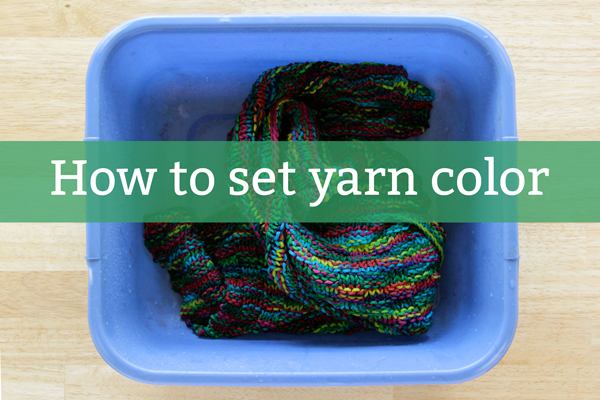
The basketweave baby blanket knitting pattern I shared recently was made with one of my favorite yarn colors ever. As much as I love the color, I noticed early on that it turned my fingers blue! I’ve never worked with a yarn that got me so blue (haha) before, but it’s a yarn that I loved because of the richness of its color – I wanted to keep my fingers dye-free and preserve the color’s vibrance. But I had no idea how to do that!
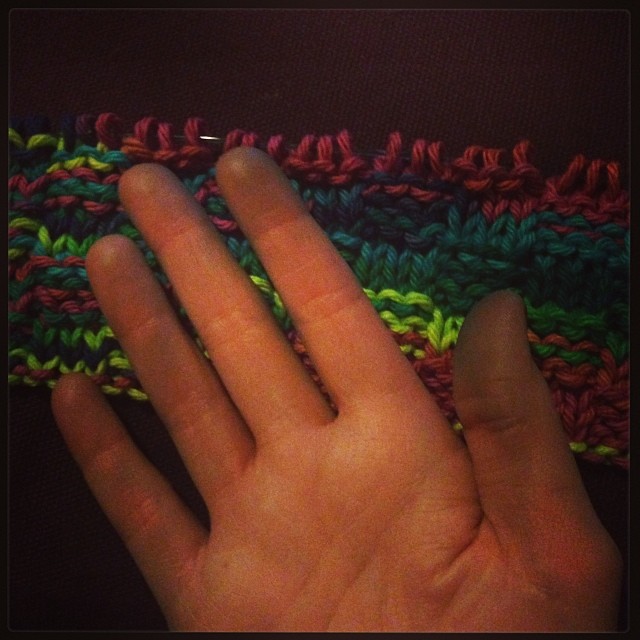
After a bit of research I learned how to set my yarn color with a vinegar bath. It’s also called making yarn colorfast. It’s great for anything from a yarn like mine that’s got lighter yellows combined with bold blues that can bleed, to a project featuring colorwork. Conveniently, you can combine the processes of this colorfast vinegar bath with blocking your finished project, so the extra color setting step is almost no trouble at all!
Supplies
finished knitting or crochet project
1 cup white vinegar
cold water
clean wash basin or sink
timer
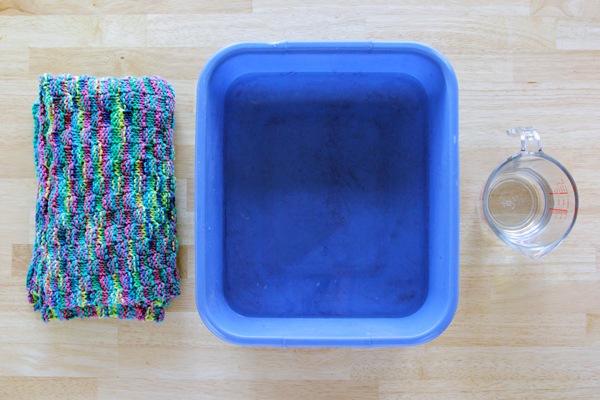
Directions
I keep this little blue tub on hand for dye projects and blocking yarn. It used to be my dirty dishes bin in college, but I love having it in my craft supply kit. It doesn’t absorb color from dyes, no matter how much I put in there, and it always washes clean. If you knit or craft a lot, I highly recommend getting a basin like mine. :) Just make sure it’s 100% clean before you put a delicate knitting project in there!
Fill your clean wash basin with cold water, and submerge your finished knitting project in it.
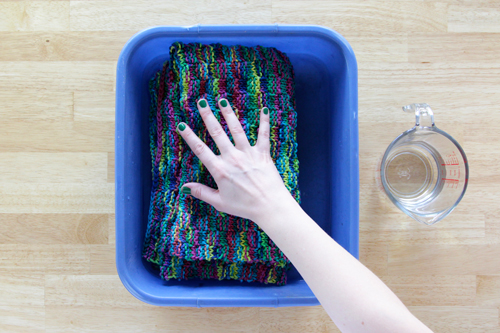
Add a cup of white vinegar to the bath, and gently mix it in.
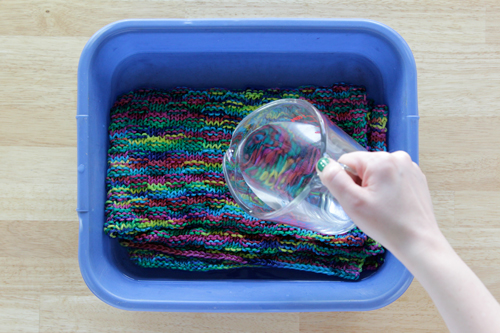
Let your project soak 30 minutes, carefully rotating it periodically. After the 30 minutes, dump out the vinegar water and rinse the project until the pickley vinegar smell is gone.
Remove excess water by gently patting or squishing it, but do not wring out your project. Wringing a project while heavy with water can ruin it.

For now, I’ll stop here, but the next step in finishing your project after setting the color is blocking it. Tomorrow I’ll have a tutorial on the basics of blocking a knitting project, and why you want to do it. Stay tuned!
Have you ever had a project bleed… to death? I’d love to hear your best (or worst) stories!
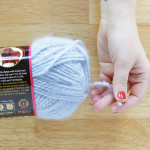
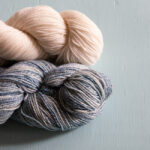

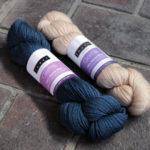


One cup vinegar to how much water?
Is the yarn a protein fiber dyed with an acid pigment? Or is it a cellulose dye with a metal mordant? How can you tell if you are setting pigments as opposed to lifting out unabsorbed excess pigment?
Would love to see photos of before, after, and several washings after.
I didn’t dye this yarn, unfortunately – it is one of the newer Sugar’n cream cotton colorways, psychedelic. I’m not a fiber dyeing expert by any means, so I don’t know what to tell you other than that it was about 1c vinegar to about a gallon and a half water.
My friend once gave me a skein of Paca Paints yarn from The Alpaca Yarn Company and I believe it was hand-dyed/painted. It was beautiful yarn, but it turned my hands blue (and green, and purple) as I knitted it into a pair of wristwarmers for a cousin. Before giving the finished gift to my cousin, I remember having to wash it out several times, but I don’t recall if I used anything as a setting agent other than just trying to wash the excess dye out with gentle detergent and water. I still have some of the yarn left over and will certainly try using white vinegar next time I knit with the yarn!
We have an alter cloth at church, woven wool, ivory. Toward bottom is a emerald green cross that has bled onto 3 areas leaving a light green stain. How can we remove the stained areas? (I believe the bleeding/staining occurred some time ago with dry-cleaning!) Would the vinegar remove this? Thank you for any help you can give.
I had a knit cotton bag that bled when I washed it. One day I was at a fabric store & discovered a product that was a dry powder & came in a small box. The product is DYLON COLOR RUN REMOVER, it worked for my problem.
I’ve used the Rit color run remover. It’s great for all-white items that have had color run on them but I’ve had it change the color of some colored items. One shirt had run dye onto its white cuffs. The color remover got all of that out but the rest of the shirt ended up a completely different color. It did it evenly so it was okay but you’ll definitely want to test it before using it on something colorful.
Hi Pat! This technique is to prevent colors from running in the future, for making fibers “colorfast”. I would look for some embroidery blogs or forums for tips on dealing with bleeding in finished projects like this. So sorry I can’t help! :(
I made a red, white and blue afghan. Finished putting the fringe on. and washed it in the washer. Red blead now the white is pink. Does anything take the color out of the white?
I need help. I did not know about the vinegar and salt.
Thanks
Patty
Hi Patty, sorry for the delay – I’ve been doing research! While I’ve never tried this myself on a finished knitting or crochet project, so please proceed with caution. My mom actually said she’d heard of people using Rit Color Remover on embroidered family heirloom projects that have bled in the wash. The post I linked to above has an active comments section where Rit staff/experts are available to help with questions you might have.
I wish you the best and would love to hear if this technique works out for you! -Heidi :)
I’m working on a baby blanket in crochet with red, ecru, and blue stripes. 18 rows in (and some very tired wrists) I realized the red might run. I really don’t what to pull it all apart, but how would one prewash yarn to get color to set when it’s in a skein?
Great question, Crystal! This tutorial might be the perfect answer to your question: http://moiraravenscroft.blogspot.com/2013/08/pre-washing-yarns.html. :)
I have used hydrogen peroxide to remove dye that has bled from another color. I have used it on colored items, although you need to be careful how long you leave it on. If there’s a way to isolate the white, you can soak it as long as you want. Then wash. It’s the ONLY thing that I’ve ever found that will take it out.
A friend (sorta) owed me $. Finally I accepted some home dyed wool as payment she assured me I could sell on eBay for much more than the debt. It bled. Working with it bled. No way was I going to sell it. I’ve been spooked by home dyeing yarn ever since. I’m almost ready to try it though. I appreciate you sharing your knowledge. Great stuff!
Courtney, just because one dyed skein of yarn bled for you doesn’t mean that all home-dyed yarns run! It all depends on how it was done. I’ve done much dyeing at home and never had a problem. However, reds are notorious for bleeding — that is just the nature of the colour.
But you CAN set the dyes when doing it yourself. Try the vinegar method. Certain dyes are not attached very firmly to the fibres, so they come out easily when wet. Indigo (blue) can crock — the dye coats the fibres and peels off on your skin by rubbing. Heat will allow the dyes to penetrate deeper into the fibres, and make them colour-fast. (or best they can be)
It is always best to wash any suspect yarns before using, just to be sure to get any excess dyes out, and to check if they bleed
Hi there – I’ve started a blanket and the dark colour is leaving blue marks on my fingers. I will have much lighter colours in this blanket as I keep going. If I try this vinegar technique when the blanket is done, will the dark colour run into the water and then onto the lighter colours of my blanket? Or should I do it when I’ve finished the skein of the dark colour, let it dry, and then keep knitting with the lighter colours?
Thanks!
To be honest, I don’t have experience with this, but I found this post on prewashing cotton yarns that might be helpful for you: http://moiraravenscroft.blogspot.com/2013/08/pre-washing-yarns.html. I know I’m saving it for my next colorful cotton project after reading it. Fascinating and useful!
Best of luck, Heidi
hello Heidi I have a very generous grandma who gave me 20+ skeins of the Sugar and Crean cotton yarn and I have more (so I’ve been happily crocheting and knitting addictivly with it). I was crocheting a pot holder and noticed the same thing! my fingers were a bluish green and I knew it was not from bad circulation… I washed my hand and the color (well most of it) went with the hand wash. One thing that is a shocking find by me about cotton yarn is that non dyed cotton yarn (white) is more absorbant than colored skeins of cotton yarn. I love crocheting and knitting. i had to wash the pot holders out to try to bleed most of the color so that it isn’t alienated to its own batch on wash day.
Oh, did I have a project bleed! Worked a month on a afghan for a wedding gift for daughters sister- in-law. We’re from Oklahoma and the couple are big OU fans. The school colors are crimson and cream. I was using “I Love This Yarn” from Hobby Lobby. Well, long store short. I didn’t know about colorfasting your projects at the time. So she got a crimson and pink afghan. I was sick and oh so embarrassed. Thank God, she was family and she loved the afghan anyway.
That’s the worst feeling! Like you said, I’m sure they loved it anyway and could appreciate all the work you put into it. Glad you’ve got a future use for this tutorial! :)
I’m just now dealing with a beautiful Crimson, white and grey afghan that ran to pink. Ttying ashing with peroxide. Next step is color catcher.
Hello Heidi. I just completed a baby’s blanket for a friend of mine who is due soon. I made the blanket in blue and white and I’m afraid washing it according to label that it will bleed due to the fact that I’ve had yarns from the same company bleed before. Can I use this method for a completed project to keep the blue bleeding in to the white? Thank you so much!
I have never tried it myself, but I have another trick I use when I worry about dye bleeds (and blues are the worst!). I use a vinegar/cold water bath, but I also add ice to make the water extra extra cold. It’s worth a shot since new mamas don’t always have the time to worry about gentle washing the handmade gifts they receive. That might help reduce bleeding as much as possible!
Hi, I am new to your website and love it, but have a question on doing the vinegar thing so my colors won’t run; after it has been in the vinegar solution for thirty minutes, you then tell us to rinse it out until all the pickly solution smell is gone, I have dishcloths I have made that are very colorful, can I run them through the washing machine on delicate or would that be a no no?
What yarn did you use, Carla? I have had good luck with machine laundering dishcloths made with Sugar’n Cream cotton yarn, but they do fade a little over time.
I made a red, white and blue afghan for a dear friend. She has a bedroom for her grandkids decorated in Americana. I was sick when I washed the afghan and it was red, pink and blue. I washed it over and over and mailed it to her anyhow. Now I know that I need to set the yarn when I am finished. Thanks.
How random I look up how to keep yarn from bleeding and bit happens to be about the exact same yarn and color I’m using!!!
Do you have any advice to offer in regards to finished amigurumi? I am using wash and dry safe polyester yarn and poly-fil stuffing. The project is a bunny of two different purples, and a white tail and tooth. I have a whale that I crocheted with the same brand and type of yarn except its multicolored, which I toss into the washer without any issues. I think maybe it isn’t as bright as it used to be, but it isn’t a problem for me. The bunny is a commissioned project and I’m a little scared to toss him into the washer. Would you suggest color-fasting at this point? Thank you in advance.
I recommend pre-washing if you’re making a project with multiple colors of yarn that you’re worried about bleeding. You might consider doing a gentle hand wash with Eucalan or Allure fiber wash at this point.
Haha Christina, same here. Just finished a dishcloth with Sugar n Cream Psychedelic; looking up how to set b/c it turned my fingers & knitting needles blue! Argh. Will also try to figure out how to make the remainder of the skein colorfast. :-/
Hello Heidi,
Does this process work with commercially-dyed acrylic yarns? If so, you may have just become the answer to my woolly prayers!
Best wishes,
Gemma
Hi Gemma,
I found this brief thread that touches on colorfasting and acrylic yarn. Some people find the vinegar solution works well, others don’t, depending on the fiber and dye in question.
Best,
Heidi
I know this is an OLD thread but would vinegar AND salt together, for acrylic yarn, work?
It’s what I’ve always used, with great success, and it’s never failed me … YET. “Knock on wood!” But I’ve not tried the more artisanal yarns, those made by home-dyers or those done by smaller companies. Mine have been made by the large yarn mashed as my budget is severely limited.
A friend bought me a skein of hand spun, hand dyed alpaca to make her a hat with. My hands and shirt were dyed pink when I finished (my finger nails are still tinged pink after multiple hand washings) I even found pink up my nose and inside my socks! I hope this vinegar bath works because I can’t imagine actually wearing this hat. Thanks!
Let me know how it goes! Luckily for you and this hat, pink isn’t the worst offender when it comes to transferring colors, and it sounds like your hat is just made of this one yarn. If so, you’ll be in the same boat as the blanket pictured in this tutorial because if the color transfers, it will just transfer back into other parts of the hat. Best of luck!
I just finished an afghan and like all my crocheted projects I washed it in my washing machine. I used Red Heart yarn except the red that I chose… couldntfind the right color in Red Heart brand so I used Crafters Secret from Hobby Lobby… the color i used was cranberry. I have this afghan sold already now the red has faded all over it. What can I do it fix it?
If it’s a solid color all over, you could try dyeing it with a colorfast dye. I found this forum thread in which someone asked about re-dyeing a faded rug, and there are some recommended dyes listed: http://jacquardproducts.com/forums/discussion/4186/dying-a-faded-wool-rug/p1. I hope this helps!
My run of good luck with nothing bleeding ran out today. My mother wanted some red white and blue placemats. I found cones of Sugar’n Cream Nautical ombré that fit the bill. Started crocheting and after a few rows my hands were blue. I’ve been reading all the other posts on this subject to figure out what to do. These are the 14 ounce cones so I don’t think totally unwinding the cone to soak it is the answer. I am hoping soaking the finished items in vinegar will do the trick. I am glad I found your website!
Thanks for a very useful tip. I love the wrap in your photo! Is it your pattern? I would like to make one like it.
The wrap pictured in the sidebar is indeed one of mine. It’s the Sixth Degree Shawl: https://www.handsoccupied.com/sixth-degree-shawl/. Enjoy! :)
I used your method of soaking my poncho (made from Interlacements, cotton rayon nylon) in white vinegar. I rinsed and rinsed it many times and then blocked it (it is a solid color). It is now light and dark on the right side and mostly light on the wrong side…what happened? Did the vinegar change the color…any suggestions?
Thank you!
Did you soak it in pure vinegar? If not, what proportion of water vs. vinegar did you use in your bath? since the poncho isn’t entirely made from natural fibers, it might be possible something happened related to the rayon and nylon in the yarn.
Hi Heidi, I was gifted some gorgeous yarn that’s wool and silk that’s not made anymore, but things I’ve read about said it runs terribly. You mentioned doing the vinegar wash to the yarn before using. How do you do that? Is it different from the vinegar was on an already-made piece? What happens with the drying part of the yarn? Would it affect blocking later on after the piece is complete?
These are all great questions that I am not qualified to answer, sadly. I’m not a trained yarn dyer or spinner – that would be the person to ask, particularly since you’re talking about silk, which is its own beast of a fiber. Best of luck! -Heidi
Hello Heidi,
I’ve used vinegar to set colors for a long long time, however, I have a hand knitted throw that is quite large, it covers the top of a Queen size mattress. How much Vinegar/water should I use with something that is this sizable? Also, how long should I keep it in the solution? Thank you so much for your help.
Sam
I would have to refer you to a yarn dyeing expert for a project of that scale – I’m not an expert yarn dyer and wouldn’t want to give you bad info that could ruin a project so much time has gone in to. FWIW, I think it might vary depending on the characteristics of the yarn the throw was knitted with – something hand dyed might behave differently than an acrylic Super Saver, for example.